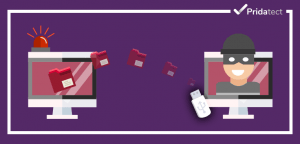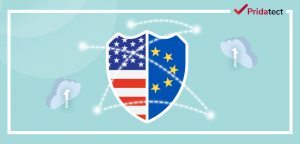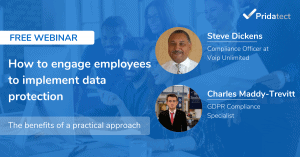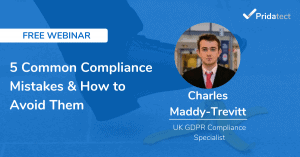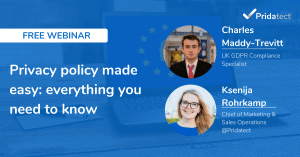It is no secret that data is used as currency in the cloud-based world which companies operate in nowadays. Whether it is to improve their products and services, or to target the right audience for their offerings, most organisations collect extensive amounts of data on a day-to-day basis. This comes with a big responsibility: the handling and storage of data bears many risks to be aware of that could not only result in damage to a company’s image, but also in financial penalties. The General Data Protection Regulation (“GDPR”) makes sure that companies keep these risks in mind and handle their clients’ data with care. With the GDPR in place, companies have to protect the personal information of their customers now more than ever. For this reason, there is a need for the implementation of sophisticated Data Loss Prevention (“DLP”) solutions that help companies to be compliant with current laws and regulation.
Data Loss Prevention – What is it and why do you need it?
In a nutshell, DLP incorporates all tools and practices that are implemented with the goal of preventing data leakage, whether it is intentional or unintentional in nature. That includes the management of accesses (so that only authorised users can view sensitive data) and the prevention of sharing data with external parties. DLP solutions are often required in order for your company to comply with industry and government regulations like the Health Insurance Portability and Accountability Act (“HIPAA”), the Payment Card Information Data Security Standard (“PCI DSS”), the California Consumer Privacy Act (“CCPA”), the Personal Information Protection and Electronic Documents Act (“PIPEDA”) and finally the already mentioned GDPR. Therefore, DLP tools can directly assist in identifying GDPR violations and ensuring that your compliant internal data protection policies are being appropriately and effectively applied in real time.
How DLP can help you to be compliant with the GDPR
The aim of the GDPR is to protect the personal data and privacy of EU citizens whenever data is transferred within EU member states. In short, the GDPR is based on six principles: Lawfulness, fairness, and transparency; Purpose limitations; Data minimization; Accuracy; Storage limitation and lastly, Integrity and confidentiality. Being non-compliant with these principles and failing to protect your customers’ data could result in expensive fines. In the following, we will give you some inputs on how DLP solutions can support you in your GDPR compliance:
Locate where data is stored
To comply with the GDPR, it is important to have an overview of where personal data is stored or processed. DLP tools help you to identify sensitive data within your processes, and show you the exact location via scans for specific infotypes. With this information, you can create reports and fully understand which data is going where at any time.
Restrict the use of personal data
One of the main requirements of the GDPR is that the stored data is only used for the purposes it was collected for. With DLP solutions, you can monitor the transfer of sensitive data in messaging apps and cloud storage. This also gives you the ability to control data transfers internally and externally, and restrict unauthorised movements. This likely exists in your data protection policies already, however being able to practically enforce said policies and avert data leaks/misuse by keeping users from uploading, copying, or printing personal information is extremely valuable.
Promote data retention limits
In accordance with the GDPR, data processors are obliged to delete data in line with a prescribed retention period. Again, the purpose the data was initially collected for plays a crucial role here: once it is fulfilled, the data has to be erased. DLP tools help you to detect data that is not in use anymore and can give admins the ability to take remedial actions such as deletion or encryption.
Prevent loss and unauthorised access
The GDPR makes companies legally responsible for data breaches. So, anytime a data leakage or a data theft happens your company can be held accountable. The implementation of DLP softwares helps you to educate employees about the way they handle data by either restricting data transfers to externals or blocking them completely when they take place outside of the companies’ networks.
Maintain data protection standards
Not only the way your own company manages data privacy is crucial for GDPR compliance, but also the security standards that your external data processors have implemented. The use of DLP tools facilitates the examination of all your data-in-transit through scans that operate according to filters. These filters can be based on the data protection standards. DLP solutions also help you to identify data breaches, report them and take the right remedial actions.
Conclusion
Data protection has many layers and is often time-consuming to execute, especially for end-users that don’t have a lot of experience in IT security. DLP solutions help to fill this gap by giving employees the ability to self-remediate their (mostly) honest mistakes in the handling of data, without penalising them. Our next generation Cloud DLP solution does exactly that. Accordingly, our solution helps you with GDPR compliance throughout your whole company and heavy penalties can be avoided – by identifying, understanding and protecting sensitive data as well as giving the right tools to employees to remediate the issues themselves. As a consequence, theoretical frameworks like policies are enforced in the real world by your employees.
What makes our DLP solution so special? It offers an all-in-one solution for your cloud apps that can be deployed easily in your own environment: You can see value within 10 minutes. It works agentless, and because of the self-remediation possibilities it has no performance impact and can monitor and identify structured as well as unstructured data with low false positive rates of between 5-10 percent.
Are you looking for a DLP solution to help you with GDPR compliance?
Contact us now for a free discovery call at!



